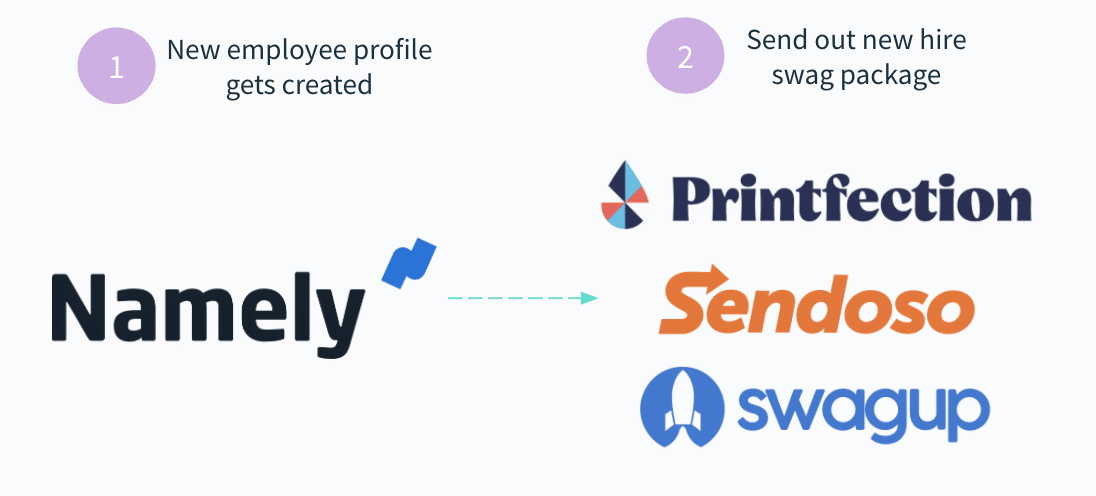The pandemic has forced roughly 40% of professionals in the EU to work remotely.
This sudden and significant change has brought along a myriad of challenges for employers.
HR teams have been tasked with quickly brainstorming and implementing strategies related to preventing employee burnout, supporting working parents, and enabling employees by providing the equipment they need to work from home.
And yet, perhaps no challenge is as difficult and as critical to tackle as employee onboarding. It serves as the very foundation of the employee experience, greatly influencing employee retention, productivity, and satisfaction.
This might leave you and your team wondering: How can you onboard employees effectively in a remote environment?
To help you address this question, we’ll offer up several approaches that you can easily apply via automation.
1. Set the new hire up with the appropriate equipment from the get-go
The role your new hire is coming into can determine the type of equipment they’ll need.
For example, customer-facing employees, like sales reps and customer success managers, may need high-quality headsets for their conversations with clients and prospects; while executives may qualify for more high-end laptops.
No matter the requirements of incoming employees, you can provide each new hire with the right set of equipment by the start of their first day through the following onboarding automation:

- Once a new hire notice* goes out to the appropriate stakeholders via an HRIS like Namely, the workflow gets triggered.
*The new hire notice can simply be an email that goes out to certain individuals and groups—like the hiring manager, the HR team, and the legal team. The email provides key details on the new hire, including their role, compensation, job location, start date, manager, etc.
- The hiring manager receives a message from a chatbot in a business communications platform, asking them to select the specific equipment their new hire needs.
- Once the hiring manager makes their selections, a regional asset manager receives a message in their business communications platform, notifying them of the request and prompting them to complete the order.
2. Provision the right set of apps for each new hire
Your new hires also likely differ in the apps they need and in the permission levels they need for each. Here are just a few examples across lines of business:
- Sales reps may need to access a CRM like Salesforce, a sales intelligence platform like Gong, and a sales engagement platform like Outreach
- Marketers may want to use a marketing automation tool like Marketo, an SEO platform like SEMrush, and an analytics tool like Google Analytics
- Engineers may look for an issue-tracking tool like GitLab, a project management app like Trello, and a tool for analysing code, like Code Climate
- Recruiters may require access to an applicant tracking system like Greenhouse, an electronic signature platform like Docusign, and an HRIS like Workday
You can give each new hire access to the apps they need from the moment they begin by implementing the following automation:

- Once the new notice gets sent by an HRIS, the workflow gets triggered.
- The hiring manager receives a notification via an HR chatbot in their business communications platform, asking them to select the specific apps they’d like to provision for the new hire. The manager can then go ahead and make their selections without leaving the business comms platform.
- An employee in IT receives the request in their business communications platform. From the platform, they can review the available licenses in the apps, approve (or reject) the request, and schedule the provisions—all in a matter of clicks.
3. Help employees connect with fellow new hires
To help new hires meet various colleagues and build meaningful relationships quickly, you can put them in a virtual hiring class.
You can even have an employee in HR join the class to help break the ice and spur conversation, if needed. For example, this employee can ask simple, open-ended questions that lead to all kinds of interesting answers, such as: “What do you like to do in your free time?” or “When you were a kid, what did you want to be when you grew up?”
To get started in building this virtual onboarding class, you can implement the following relatively simple automation:
- A chatbot searches your HRIS for employees who’ve started in the past month.
- Once it’s identified the new hires, a channel gets created for the hiring class in a business communications platform, and the new hires get added to it.
4. Facilitate one-on-one lunches
As valuable as it is to join a cohort of fellow new hires, one-on-one lunches present an entirely different opportunity for socialisation.
It gives those who are more introverted an easier chance to engage in conversation, and it allows employees to connect with one another on a deeper level—both professionally and personally—than they could in a group setting.
For these reasons, and many others, you should kickstart a program that invites new hires to have lunches with one another virtually. Here’s an automation that can help you do just that:
- A chatbot looks for employees who’ve started on a certain date in your HRIS, and once it identifies them, the workflow gets triggered.
- The chatbot pairs up new hires, and then sends each pair a Google Calendar invite that includes a link to a virtual meeting via RingCentral.
- The chatbot purchases a gift card from a food delivery service (by the amount you’ve allotted) for each new hire.
Note: You can easily change both the amount you’d like to allot per meal as well as the app that’s used to deliver the meals.
- Shortly before the lunch, the chatbot provides the new hires with the food delivery gift card codes via a business communications platform, allowing each participant to enjoy a free meal as they meet their new colleague.
5. Send the new hire some swag
You can help your new hire stay excited about their role and even further their enthusiasm by providing them with company-branded swag. This can take the form of practical, everyday items, like mugs, hats, and shirts, as well as more lucrative goods, like bluetooth speakers, leather backpacks, or outdoor jackets.
Whatever you’d like to reward your employees with, you can do so easily with the following automation:

- Once an employee gets added to an HRIS like Namely, the workflow gets triggered.
- A gift-giving app (like any of the three highlighted above) sends the new hire a predetermined gift, using the address in the new hire’s HRIS profile.
At this point, you likely have a rough understanding of how an effective virtual onboarding program delivers value to your employees and to your organisation more broadly. We’ll help clarify its benefits in the following section.
Benefits of an effective virtual onboarding program
Here are just three reasons why providing a best-in-class onboarding program is well worth the effort:

Let’s take a closer look at each of them.
1. Fosters employee connections
The feeling of loneliness and isolation can easily crop up among employees working remotely.
In fact, according to a study by Buffer, roughly one in five employees who work remotely said it’s made them feel lonely. And when you consider that—according to the same study—99% of employees would like to work remotely (at least some of the time) for the rest of their careers, it’s clear that concrete actions need to be taken by employers.
As you saw in some of the previous examples, you can implement onboarding automations to help mitigate employees’ feelings of loneliness. One of the automations can help new hires easily engage with one another in a group setting via a platform they’re already working on. Another can help facilitate a variety of one on one meetings between new teammates early in their tenures, allowing new hires to build a variety of meaningful connections, quickly.
Camaraderie between colleagues doesn’t just improve employees’ mental health—it can also be key to facilitating employee satisfaction and productivity. Research by the Boston Consulting Group proved this to be the case when it studied employees who worked from home during the pandemic.
Through their research, they found that employees who are happy with their social relationships with colleagues are two to three times more productive on collaborative tasks, on average, than those who aren’t satisfied.
2. Enables employees to hit the ground running
As new hires embark on a new role, they’re eager to make an early impact.
A well-run virtual onboarding program that incorporates automation lets them do just that. Why is that the case? Because instead of having new hires manually request access to apps and equipment once they join (which could prevent them from receiving these items for several days, if not weeks), they can get access to everything they need to be productive as soon as they come on board.
Moreover, hiring managers and employees in HR are set to benefit, as an automated provisioning process allows them to request or approve apps and equipment within their business communications platform.
This provides hiring managers and employees in HR with significant time savings—as they don’t have to hop between apps to make requests and complete approvals—and it allows them to avoid costly mistakes, as much of the manual work is streamlined.
3. Improves your employer brand
Your employer brand can be influenced by a variety of inputs, from your reviews on a site like Glassdoor to the reputation of your c-suite.
A strong employee onboarding program directly contributes to many of these inputs. For instance, going back to our previous examples, it may prompt a new hire to leave a positive review of your organisation in Glassdoor, and it might lead a member of your c-suite to discuss the success of your organisation’s onboarding program at an event.
These improvements to your employer brand can provide significant value for your business.
It can help your organisation attract a wealth of qualified applicants, as 86% of professionals say that they’re likely to review companies’ ratings before deciding where they apply. It can also provide your organisation with significant savings, as a bad reputation can—according to Linkedin—cost your organisation nearly $5,000 per employee. It can even improve employee retention, as Linkedin also found that organisations with a strong employer brand experience 28% lower turnover than those with a weaker employer brand.
How to implement a better remote onboarding experience
Using integration-led automation, you can power all of the onboarding automations covered above—among countless others—to help your business provide a best-in-class virtual onboarding experience.
When planning to automate your onboarding, you can learn more about using a low-code/no-code platform and better understand how the platform can help you get more out of RingCentral by visiting this page.
Originally published Jun 17, 2021

